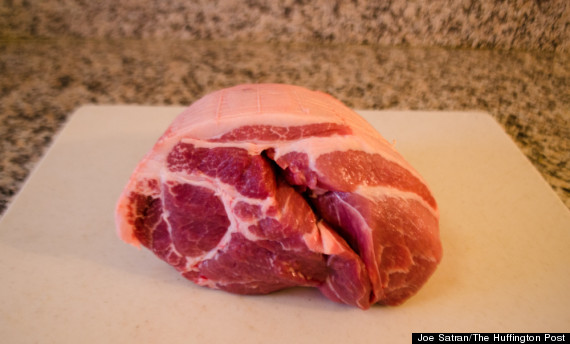But ultra-slow cooking is nothing new to chef Daniel Patterson, of the world-renowned Coi restaurant in San Francisco. He started doing it in 1994, at home. And unlike barbecue and sous vide, his technique requires no special equipment. Indeed, it's so easy that you can literally do it in your sleep. Here's his secret: set the oven to a very low temperature.

"There's low temperature and there's low temperature. Normally, between 250 and 300 would be considered low-temperature cooking; that's what you'd set the oven at if you were making a traditional braised dish, for example, and you'd keep it in for three hours," he said. "But I like to drop it down to 180 -- and then cook it overnight."
180 degrees Fahrenheit is just about the lowest temperature setting most ovens can reach. It's not all that much hotter than a dehydrator! Which is why you have to cook the meat for so long.
"When you set the oven that low, it just extends the cooking time, but you also get a deeper flavor and the texture of the meat is a little juicier," Patterson explained. "It retains more of its natural structure. The breakdown of collagen and gelatin is slower."
Patterson first experimented with this radically low cooking temperature using a whole pork shoulder, but he also regularly uses it for braised meat, like oxtail or short ribs.
"It could be duck confit. It could be braised beef. It could be anything," he said. "The idea is that you put it in before you go to bed, and when you wake up, it's done."
I tried the technique out at home -- and it produced some awesome, and surprising, results. I put half of a boneless pork shoulder in a 180-degree oven during "How To Get Away With Murder" on Thursday night, and then when I woke up on Friday, my entire apartment was perfumed with the smell of pork fat, and a deliciously tender hunk of meat was waiting in the oven. I had expected it to have the taste and texture of either carnitas or bo ssam, but in fact, it was something else altogether: the meat kept essentially the same shape throughout the cooking process, and it didn't have the flaky texture of either of those pork dishes. Instead, it had a kind of gelatinous bounce to it. It reminded me a little of fatty barbecued brisket, but even that's not quite right. It was a truly novel experience.
Here are step-by-step instructions if you want to try it out yourself:
Start with a piece of boneless pork shoulder slightly smaller in all directions than the Dutch oven or roasting pan in which you plan to cook it; in my case, this was almost exactly half a whole shoulder.

If there's a twine net holding the piece of shoulder together, remove it, then open up the cavity and sprinkle a healthy dose of salt and pepper on all sides of the meat.

Put a generous layer of chopped garlic and fresh thyme leaves in the cavity of the shoulder, where the bone once was.

Seal the shoulder back up so it's basically the shape it was before you stuffed the cavity and place it in a Dutch oven or a roasting pan with high sides. The height of the sides is crucial, because a great deal of fat and juice will emerge from the meat as it roasts. Patterson learned this the hard way the first time he experimented with this technique; he used a cookie sheet, and so much fat rendered off the meat that he was awoken the next morning by the sound of his dog licking it off the floor.

Pre-heat your oven to 180 degrees Fahrenheit. If you're using a Dutch oven, put the lid on; if you're using a roasting pan, cover it with aluminum foil. Put the meat in the oven and leave it alone for 11 or 12 hours. While it cooks, feel free to go to bed.

Wake up the next morning and take the pork out of the oven. When you open the lid (or remove the aluminum foil) you should have something that looks kinda like this.

Carefully remove the meat from the juices and place it on a cutting board. You should probably keep the juices; if you refrigerate them, the fat will rise to the top and solidify, allowing you to harvest it for potato roasting or lard bread making.

Finally, chop the meat to your satisfaction using a big knife. If you followed our advice and let it cook while you slept, you probably don't want to eat it for several more hours, in which case, you can put the meat back in the Dutch oven, topped with a little juice, and keep it in the fridge until you're ready to serve. Just reheat it for a few minutes in a 250 degree oven.

Want to read more from HuffPost Taste? Follow us on Twitter, Facebook, Pinterest and Tumblr.
Source: http://www.huffingtonpost.com/2014/10/31/chef-daniel-patterson_n_6085240.html?utm_hp_ref=travel&ir=Travel and provided by entertainment-movie-news.com
No comments:
Post a Comment